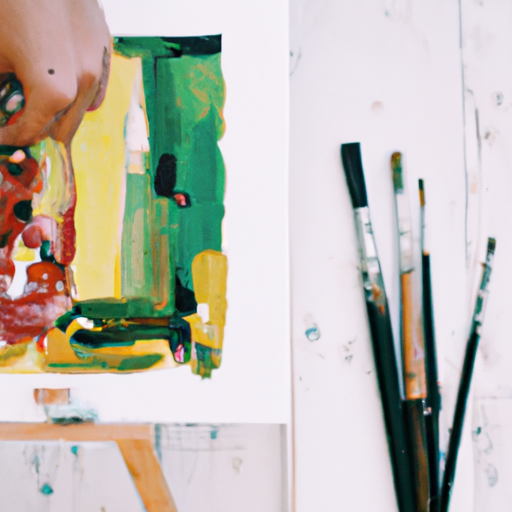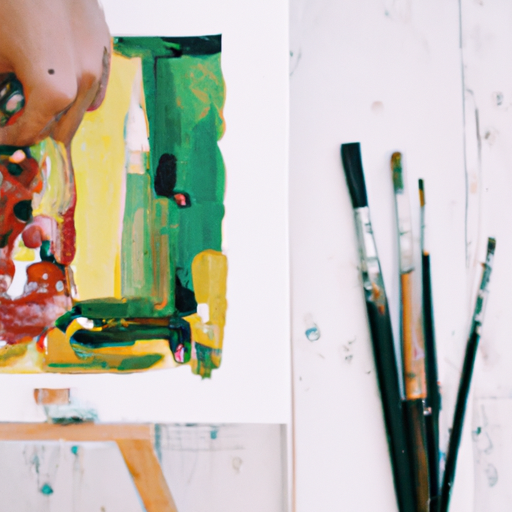Hey there! Have you ever wondered how to make your content stand out and grab your audience’s attention? Well, in this article, we’re going to dive into the world of content canvases and explore how they can take your content creation to the next level.
So, what exactly are content canvases? Don’t worry, we’re going to explain it all. From understanding what content canvases are to learning how to use them effectively, we’ll cover it all. By the end of this article, you’ll have a clear understanding of how content canvases can enhance your content strategy and make your message truly shine. So, if you’re ready to up your content game, keep reading and let’s get started!
Canvases
When it comes to creating art, the canvas is an essential tool that artists have been using for centuries. The canvas serves as the foundation for a wide range of artistic techniques and is available in various types and sizes to suit different artistic needs. In this article, we will explore the history of canvases, the different types available, how to choose the right canvas, techniques for preparing and painting on canvases, caring for canvases, alternatives to canvases, and the role of canvases in the works of famous artists. We will also touch upon the trends in modern art concerning experimental canvases and new digital canvas technologies.

History of Canvases
Origin of Canvases
The use of canvases in art can be traced back to ancient times. The ancient Egyptians were one of the early civilizations to use canvas-like materials for their paintings. They would stretch linen cloth over wooden frames, creating a surface suitable for painting.
Evolution of Canvases
The use of canvas continued throughout history, with different cultures experimenting with various materials and techniques. During the Renaissance period, European artists started using canvases made from woven fabrics such as linen. Linen canvases were preferred due to their durability and smooth surface, which allowed for intricate details in paintings.
In the 17th century, the popularity of canvas grew even further. Artists began using canvas as a replacement for wooden panels, as it was lighter, easier to transport, and less prone to warping. Canvas also allowed for larger-scale paintings, which became increasingly popular during this time.
Different Types of Canvases
Canvases come in different types and materials, each with its own unique characteristics. The choice of canvas depends on the artist’s preference and the desired outcome of the artwork.
Cotton Canvases
Cotton canvases are one of the most commonly used types of canvases today. They are affordable, lightweight, and provide a smooth surface for painting. Cotton canvases are suitable for various painting techniques, including oil, acrylic, and mixed media. However, they are less durable than other types of canvases and may stretch or shrink over time.
Linen Canvases
Linen canvases are known for their superior quality and durability. They have been used by artists for centuries due to their resistance to rot and decay. Linen canvases have a tighter weave than cotton canvases, providing a more stable surface for painting. They are suitable for all painting techniques and are commonly favored by professional artists.
Polyester Canvases
Polyester canvases are a newer addition to the canvas market. They offer a lightweight and synthetic alternative to traditional canvases. Polyester canvases are resistant to moisture and UV damage, making them ideal for outdoor paintings. However, they may not provide the same texture and feel as cotton or linen canvases.
Choosing the Right Canvas
Choosing the right canvas is crucial for the success of your artwork. Consider the following factors when selecting a canvas:
Factors to Consider
-
Painting Technique: Different canvases suit various painting techniques. Consider the requirements of your chosen medium (oil, acrylic, etc.) and choose a canvas that complements it.
-
Durability: Depending on the longevity you desire for your artwork, consider the durability of the canvas material. Linen canvases are known for their longevity, while cotton canvases are more affordable but may not last as long.
-
Texture: The texture of the canvas surface can greatly affect the final appearance of your painting. Some artists prefer a smoother surface, while others enjoy the texture provided by a slightly rougher canvas.
Sizing and Priming
After selecting the type of canvas, consider the size and priming of the canvas. Canvases come in various sizes, from small art panels to large-scale installations. Choose a size that best suits your artistic vision and the space available for display.
Priming the canvas is another essential step before painting. Priming refers to applying a preparatory layer of gesso to the canvas to create a smooth and stable surface. The process helps prevent the absorption of paint into the canvas fibers and enhances the longevity of the artwork.

Preparing the Canvas
Before painting, it is crucial to properly stretch and prime the canvas to ensure a stable and suitable surface for your artwork.
Stretching the Canvas
Stretching a canvas involves attaching it firmly to a wooden frame or stretcher bars. This process eliminates any wrinkles or sagging in the canvas and provides a taut surface. You can either purchase pre-stretched canvases or stretch the canvas yourself using stretcher bars and a staple gun.
Priming the Canvas
As mentioned earlier, priming the canvas is a necessary step before painting. Gesso, a white acrylic-based primer, is typically used for this purpose. Apply several layers of gesso, allowing each layer to dry before applying the next. This creates a smooth, white surface that enhances the vibrancy and adhesion of the paint.
Art Techniques on Canvases
Canvases are versatile surfaces that can be used for various painting techniques. The most commonly used techniques on canvases include oil painting, acrylic painting, and mixed media.
Oil Painting on Canvases
Oil painting on canvases is a traditional and widely practiced technique. The flexibility and absorbency of the canvas allow for the slow drying nature of oil paint. The texture and tooth of the canvas surface also add depth and character to oil paintings.
Acrylic Painting on Canvases
Acrylic paints are known for their fast-drying properties, making them an excellent choice for artists who want to work quickly. Canvases provide a suitable surface for acrylic painting as they are flexible and allow the paint to bind well. The versatility of acrylics allows for various techniques, from thin washes to thick impasto applications, all achievable on canvases.
Mixed Media on Canvases
Mixed media artists often choose canvases as a substrate for their artwork. Canvases can handle multiple mediums, such as collage, ink, markers, and more. The ability to combine different materials and techniques on a canvas creates a diverse and textured result.
Caring for Canvases
Proper care and maintenance of canvases are crucial to ensure their longevity and preservation. Here are some tips for caring for your canvases:
Cleaning Canvases
Regularly dust your canvas paintings using a soft, dry brush or a microfiber cloth. Avoid using any liquid cleaners or harsh chemicals, as they can damage the paint or the canvas surface. If necessary, consult a professional conservator for more extensive cleaning.
Storing Canvases
Store your canvases in a cool, dry place away from direct sunlight and extreme temperature changes. Avoid stacking canvases on top of each other, as this can lead to crushing or warping. Consider using acid-free tissue paper or cardboard to protect the surface of your canvases.
Canvas Alternatives
While canvases are the most popular choice for artists, there are alternative surfaces that artists can explore for their artwork:
Wood Panels
Wood panels provide a sturdy and durable alternative to canvases. They offer a smooth and solid surface for painting and are less prone to warping. Wood panels can be primed and prepared similarly to canvases, making them suitable for various painting techniques.
Paper
Paper is a versatile and lightweight alternative to canvases. Artists can choose from a wide range of paper types, including watercolor paper, drawing paper, or specialty papers. Each paper type offers its unique qualities and is well-suited for different mediums and techniques.
Metal
Metal surfaces, such as aluminum panels or copper plates, provide a unique and contemporary alternative to canvases. These surfaces offer a smooth and sleek appearance, and the reflective nature of metal can add depth and dimension to artwork. Metal surfaces are suitable for various painting techniques and are especially popular in abstract and modern art.
Famous Artists and Canvases
Throughout art history, canvases have played a significant role in the works of famous artists. From the Renaissance masters to modern-day artists, canvases have been a canvas of choice for countless masterpieces.
One such example is Leonardo da Vinci’s “Mona Lisa,” which was painted on a wooden panel covered with primer and a white lead preparation. Vincent van Gogh, known for his iconic paintings, often used stretched canvases for his vibrant and expressive artwork. Canvases have been a staple in the works of numerous other famous artists, providing them with a versatile and reliable surface for their creativity.
Canvas Trends in Modern Art
As modern art continues to evolve, artists are exploring new possibilities and pushing the boundaries of traditional canvases. Some current trends in canvas usage include:
Experimental Canvases
Artists are utilizing unconventional materials and techniques to create experimental canvases. This includes incorporating found objects, textiles, or even three-dimensional elements to add texture and depth to the artwork. These experimental canvases challenge the traditional notions of what a canvas can be and encourage viewers to engage with art in new and exciting ways.
New Digital Canvas Technologies
With the advancements in technology, digital canvases are becoming increasingly popular among artists. Digital canvases allow artists to create and display their artwork digitally, providing new possibilities for interactive and multimedia experiences. These digital canvas technologies open up a whole new realm of creativity and artistic expression.
Conclusion
From its ancient origins to the present day, canvases have continued to be a vital tool in the world of art. Whether you choose a cotton, linen, or polyester canvas, each type offers its unique qualities and allows for diverse artistic techniques. By properly preparing, painting, and caring for your canvases, you can create stunning artworks that will stand the test of time. And as the world of art continues to evolve, new trends and technologies will shape the future of canvases and the ways in which artists express their creativity. So, pick up a canvas and let your imagination soar as you paint your artistic vision onto this timeless medium.

